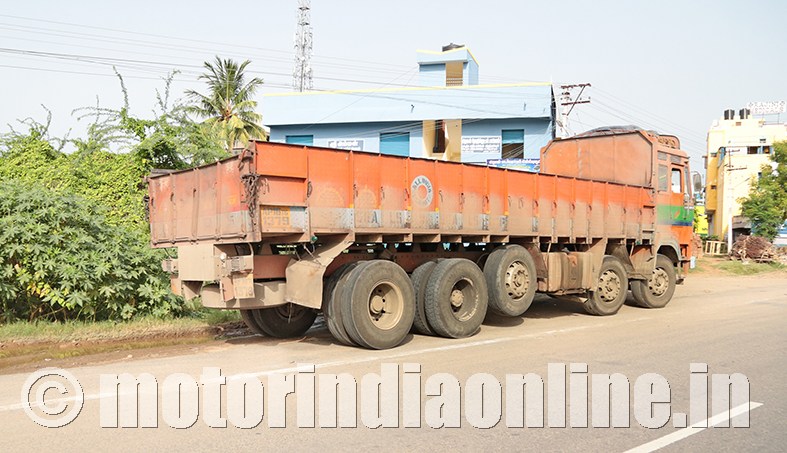Regulations pose challenging times ahead with the new axle load norms announced set to disrupt OEM operations and dampen sales in the short-term
It has been a tough time indeed for the CV sector from mid-July ’18. Till then, most of the players were actively focussing on ramping up their production after having posted impressive Q1 FY19 results. Various BS-VI and EV related activities were also gathering pace and with the overall economy looking northwards, expectation of a good FY19 was very much on the cards. After the stretched period of difficult times following the FY17 demonetisation hangover, GST and BS-IV transition during H1 FY 18, the sector digesting the major disruptions started performing well during H2 FY18. The trend continued in Q1 of this financial year and the vibrancy of the sector was palpable but alas, the new axle norm notification issued by Ministry of Road Transport & Highways (MoRTH) on July 16 has come like a bolt from the blue. One more challenge has thus been posed and lack of clarity following the notification has only escalated the confusion and dampened the sentiments. During that week-end started the all India truckers strike disrupting the overall transport operations; and the protests were for issues connected with e-way bill and high toll charges to escalating diesel prices. Thankfully the government agreed to sort out the issues and the strike was withdrawn after about 10 days, leading to an estimated direct and indirect loss of Rs. 50,000 crores to the economy. Can an agitation such as above in the trucking segment become a norm in response to the regulations planned for implementation in future?; let’s hope not and regard the same as an isolated instance and an exception.

Axle load norm revision
OEMs have every reason to feel disappointed, confused and worried due to the MoRTH notification. MoRTH thro’ the notification increased the maximum capacity of axle load limit across various categories to keep the limit on par with international standards. This meant the rigid chassis axle ratings to change as, 2-axle GVW 16.2 ton to 19 ton, 3-axle GVW 25 ton to 28.5 ton, 4-axle GVW 31 ton 36 ton & 5-axle GVW 37 ton to 43.5 ton and similarly in the tractor-trailer class. The amendment lays down that the GVW will not exceed the total permissible safe axle weight specified and in no case shall exceed 49 ton in case of rigid vehicles and 55 ton in the case of semi-articulated trailers and truck-trailers except modular hydraulic trailers. The OEMs were taken aback as there appeared to be no discussions or debates with the stakeholders on the subject leave alone the timing of the new norm – disappointment hence was natural. Confused yes, as it was not clear whether the application of new norms will be prospective or retrospective. While the former will lead to some time delays, the latter significantly affect their sales; retrospective will mean that even the existing vehicles be allowed to carry the increased loads with/without modifications. The worry factor arises from the loss of business in the short/medium term and push them back to those testing times faced couple of years ago.
Mr. Vinod K. Dasari, CEO and MD of Ashok Leyland, during an exclusive interaction with MOTORINDIA team, said: “I am not sure why it was introduced and have no idea. They say the roads are better and hence we are increasing the axle loads. However, the common man’s thinking about roads is very different. The argument is that anyhow we are overloading and hence we will make it legal now; and we will now be serious in issuing penalty for overloads beyond that notified. What has been overloaded, people will continue to overload is my worry; and it will go even higher. Something that was 37 ton yesterday is now 43.5 ton. So a fleet operator having 37 ton vehicles may say when the 43 ton vehicle is introduced, it will be expensive. Hence why wait till that time and I might as well buy the 37 ton vehicle and overload it. We design our vehicles for overload but if someone drives all types of trucks with overloads and still trying to reach the speed, he is burning more fuel, wearing out brakes faster, weakening the suspension and lowering tyre life. To meet the revised norms, I talked to my product development people. About 800 different tests have to be done and the product development team has stopped all work for the next 2 to 3 weeks, do nothing except this. Every single vehicle in its class will have to be checked up for new loads and changes made as needed. Every manufacturer will now go to ARAI for approval and I find this entirely unwarranted at this juncture.”
Mr. Dasari went on to add: “More importantly as the confirmation has also been given for old vehicles but with necessary modifications to meet the revised norms, customers are going to the RTO to get the approval; and RTO is saying go to the OEM. Why will we certify after having already got the vehicle certified as per CMVR for 37 ton, now as suited for 43.5 ton? how can we certify used vehicles? For new vehicles with necessary changes and tests done, yes, we can do it. As regards the impact on sales, 60% of the vehicles are not affected, viz., tippers, ICVs, oil tankers, bulkers, car carriers, 2-wheeler carriers, LPG bullets, etc., where volumetric parameter is the criterion for purchase; only the market load and like applications will get affected. However that 40% segment buyers will figure out the developments, wait and settle for new vehicles though likely to be more expensive.”
Impact on operations
OEMs and their suppliers have taken up the gargantuan task of leapfrogging to BS-VI from BS-IV in 3 years, skipping the BS-V. This has not been achieved by the CV players the world over and typically the transition made in 10 years or more. After the BS-IV experience, the OEMs know that the deadline of April 2020 is sacrosanct and this means deploying all their resources in a hurry and with utmost seriousness to meet it. During the work in process, the government asked the players to plan for switching over to all electric by 2030. This has been perceived as an unrealistic time horizon even by world standards and the government after taking the feedback relaxed this ambitious norm by not announcing it as a policy. However, EV transition is imminent and in sync the global trend, thrust in India will be definitely be on electric considering the enormous benefits. The EV move provides also a great opportunity for India to take on the global competition on a level playing field. BS-VI in conjunction with EV is definitely a case of ‘biting off more than one can chew’ but then domain players wouldn’t like to let go off the golden opportunity. Now comes the axle norm regulation burden and we can understand the plea of the players to leave them alone to attend to their current mammoth workloads; and not introduce any further regulation to divert their attention and dilute the finite resources on many projects. All they want is that breathing space to concentrate on their critical work in process and a clear roadmap from the government to firm up their approach down the timeline.
Fleet operators have had their success thro’ the recent all India strike; and taking its fallout as a cue it’s feared that with general elections in April/May 2019, government may go soft several of the progressive measures in the pipeline like the amendment to motor vehicle act and 20 years scrappage policy. It has been reported in the press that the PMO has returned back the draft note of scrappage policy to MoRTH asking for amendments and the same perceived as a move to buy time. Extrapolating the government moves, it will not come as a surprise if they allow all the old vehicles to automatically move over to the new axle load rating norm with no changes; and if it happens, the same could lead to issues/confusions regarding safety, guarantee, insurance, etc. Another development that did not go unnoticed was about two of the multinational CV companies operating in India making the moves to exit the Indian scene. The developments are not a good sign at all and it’s fervently hoped that government has a relook at all the regulations including those in pipeline; discuss the details with stakeholders and implement it considering the interests of CV sector and the growth of the nation in the long run.
